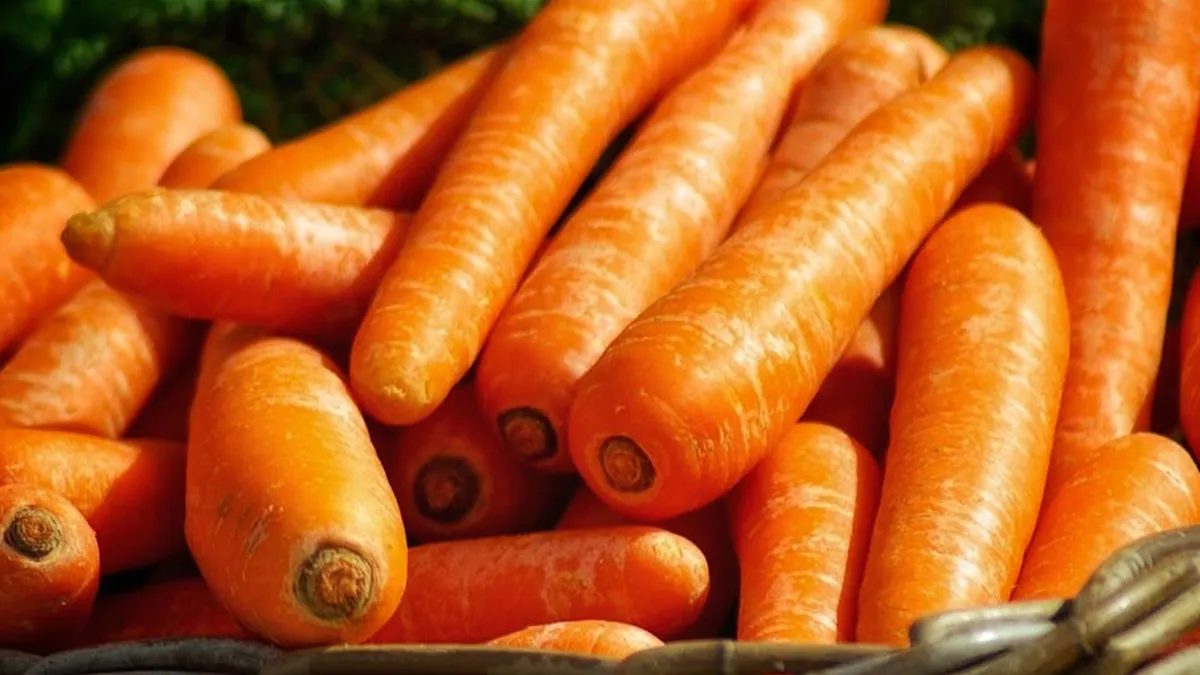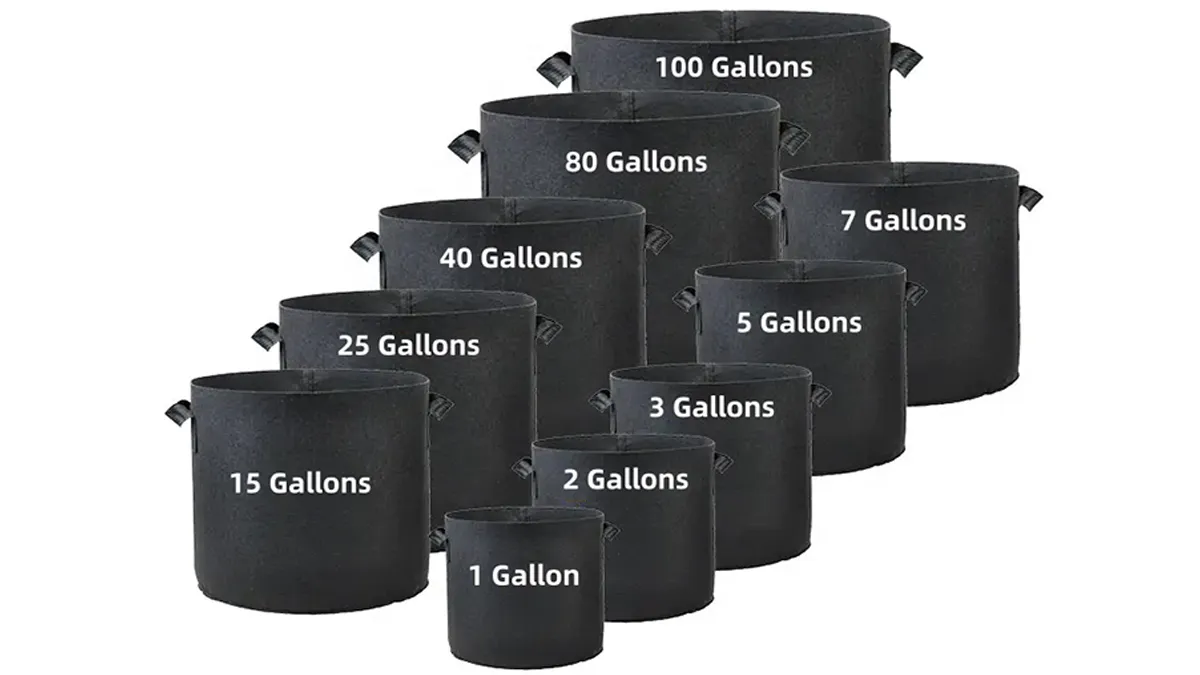Choosing the right grow bag is crucial for growing healthy, straight carrots. The size and depth of the grow bag can impact root development, yield, and overall survival rate. Below, we’ll explain the ideal grow bag sizes for different carrot varieties, the number of plants per bag, planting tips, common mistakes, and frequently asked questions.

Why Grow Carrots in Grow Bags?
Before we get into bag sizes, here’s why grow bags make growing carrots so much easier:
- Better Drainage: Carrots hate soggy soil. Grow bags naturally improve drainage and prevent waterlogging.
- Air Pruning: Roots don’t circle around like in plastic pots. Instead, they stop at the fabric wall, promoting stronger, straighter carrot growth.
- Space-Saving: Perfect for patios, balconies, or small gardens.
- Easy to Move: You can adjust the bags to follow the sun.
- Simpler Harvest: Just tip the bag over and collect your carrots—no digging needed.
What Size Grow Bag is Best for Carrots?

When you grow carrots, the depth of the bag is way more important than the width. Carrots are root vegetables, which means they grow down into the soil rather than outwards. If the bag is too shallow, your carrots might end up short, stubby, or even crooked. You want a bag that’s deep enough so the roots can stretch out freely and develop into nice, long carrots.
Besides depth, the soil itself matters too. Loose, well-draining soil helps the roots grow straight and prevents them from getting stuck or twisted. Avoid compacted or heavy clay soil—your carrots will have a hard time growing properly. Think of the bag like a mini carrot playground: the deeper and fluffier it is, the happier your carrots will be!
Recommended Sizes:
- Small Grow Bags (5 gallons, 10–12 inches deep)
- Good for short or “baby” carrot varieties (like Parisian or Thumbelina).
- Limited harvest quantity.
- Medium Grow Bags (7–10 gallons, 12–14 inches deep)
- The most versatile option.
- Works for standard carrot varieties such as Nantes or Chantenay.
- Suitable for 20–30 carrots per bag.
- Large Grow Bags (15–20 gallons, 16–18 inches deep)
- Best for long varieties such as Imperator or Danvers.
- Can grow a high volume of carrots, up to 40–50 per bag.
- Requires more soil and space.
Comparison Table: Grow Bag Sizes for Carrots
| Grow Bag Size | Depth (inches) | Suitable Varieties | Seed Carrots Per Bag | Best For |
|---|---|---|---|---|
| 5 gallons | 10–12 | Baby carrots, round carrots | 10–15 | Beginners, small spaces |
| 7–10 gallons | 12–14 | Nantes, Chantenay | 20–30 | Home gardeners |
| 15–20 gallons | 16–18 | Danvers, Imperator | 40–50 | Larger families, high yields |
How Many Carrots Can You Plant in Each Grow Bag?
When it comes to planting carrots in grow bags, spacing is just as important as bag size. If you cram too many seeds into one bag, the roots will compete for nutrients, water, and room to grow, which usually results in small, stunted carrots. On the other hand, giving each carrot enough space allows it to develop properly and makes harvesting much easier.
- Rule of thumb: 1 carrot per 2–3 inches of surface space.
- In a 10-gallon bag, you can comfortably plant 20–30 carrots.
- Avoid overcrowding—too many seeds in one bag lead to stunted growth.
Factors to Consider When Choosing Grow Bag Size
- Carrot Variety
- Short carrots = shallow bags are fine.
- Long carrots = deeper bags required.
- Available Space
- Balcony gardeners may prefer multiple smaller bags.
- Larger gardens can accommodate 15–20 gallon bags.
- Harvest Goals
- Small harvest for snacks? A 5–7 gallon bag is enough.
- Want storage carrots for weeks? Choose 15–20 gallon bags.
- Climate and Soil Needs
- Hot climates dry soil faster in larger bags.
- Make sure depth is always loose, not compacted.
Tips for Growing Carrots in Grow Bags
1. Soil Preparation
Start with loose, sandy, well-draining soil. Carrots need room to grow down, so avoid heavy clay or compacted soil that can cause roots to fork or twist. Adding some compost or aged manure not only loosens the soil but also provides essential nutrients for healthy growth. Think of it like giving your carrots a soft bed to stretch out in.
2. Sow Thinly
Scatter seeds lightly on the soil surface and cover them with a thin layer of soil. Once seedlings emerge, thin them out so each carrot has enough space to develop fully. Crowded carrots will compete for water, nutrients, and space, leading to stunted or misshapen roots. A simple trick: use a toothpick or small marker to help maintain even spacing.
3. Depth Matters
Make sure the grow bag is deep enough for your carrot variety. Short baby carrots can manage with 10–12 inches, but long types like Imperator or Danvers need at least 16 inches. Depth ensures roots grow straight and don’t curl at the bottom. You can even layer soil gradually as roots grow, a technique called “hilling,” which helps maximize bag space and yield.
4. Water Consistently
Carrots don’t like dry spells followed by heavy watering. Inconsistent moisture causes cracking and splitting of the roots. Water evenly, keeping the soil damp but not soggy. Grow bags tend to dry out faster than garden soil, so check daily, especially on hot or windy days. Mulching the top with straw or shredded leaves helps retain moisture.
5. Fertilize Smartly
Carrots need a balanced nutrient supply. Too much nitrogen encourages leafy tops but weak roots, while too little phosphorus or potassium slows root development. Use a light, balanced fertilizer or compost mix to feed your carrots. Slow-release fertilizers work well in grow bags, reducing the risk of overfeeding.
Common Mistakes to Avoid
- Using bags that are too shallow → results in stubby or deformed carrots.
- Overcrowding seeds → competition and small carrots.
- Overwatering → root rot and poor development.
- Neglecting sunlight → carrots need at least 6–8 hours of sun daily.
Alternatives to Grow Bags for Carrots
- Raised Beds: Good for large harvests but less portable.
- Plastic Pots: Hold moisture but can restrict root growth.
- Traditional Ground Planting: Works well but requires digging and more space.
Conclusion
The right grow bag size for carrots depends on the variety and your harvest goals. In general:
- 5 gallons (10–12 inches deep) → baby carrots
- 7–10 gallons (12–14 inches deep) → standard varieties
- 15–20 gallons (16–18 inches deep) → long carrots & large harvests
With the right size, proper soil, and consistent care, grow bags can make carrot growing simple and productive.
As a manufacturer of high-quality grow bags, we supply durable, customizable options for distributors, retailers, and agricultural brands worldwide. If your business is sourcing grow bags in bulk, we provide tailored solutions in various sizes, materials, and branding options to help you meet market demand.
FAQs
How deep should a grow bag be for carrots?
At least 12 inches for most varieties; 16–18 inches if growing long types like Imperator.
Can I reuse grow bags for carrots every season?
Yes, but refresh the soil each time to avoid nutrient depletion and pests.
Do carrots need full sun in grow bags?
Yes. They require 6–8 hours of direct sunlight daily for best growth.
How many carrots can I grow in a 10-gallon grow bag?
Around 20–30 carrots, depending on spacing.
Are grow bags better than pots for carrots?
Yes. Grow bags provide better drainage and air pruning, resulting in straighter, healthier carrots.





